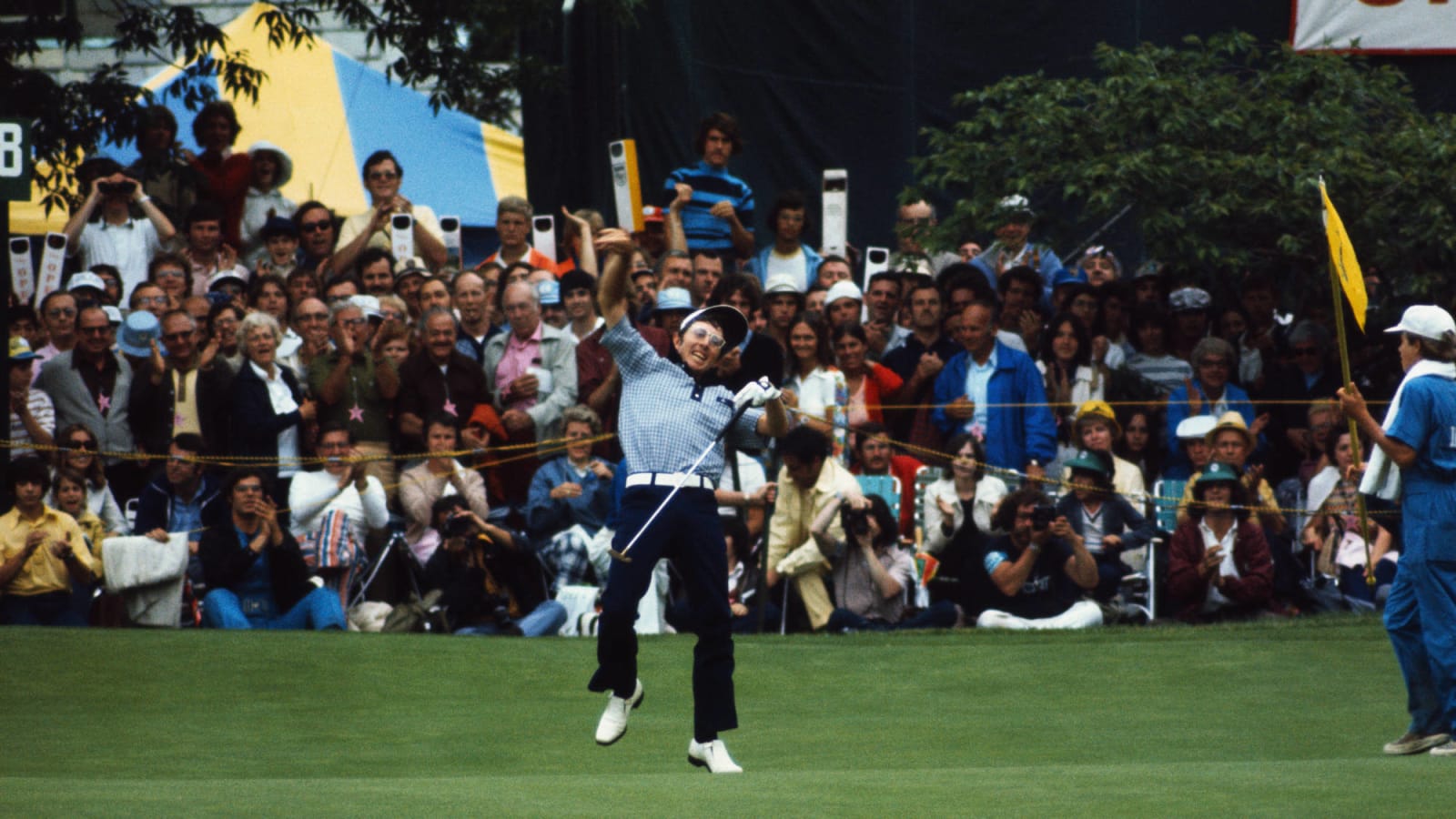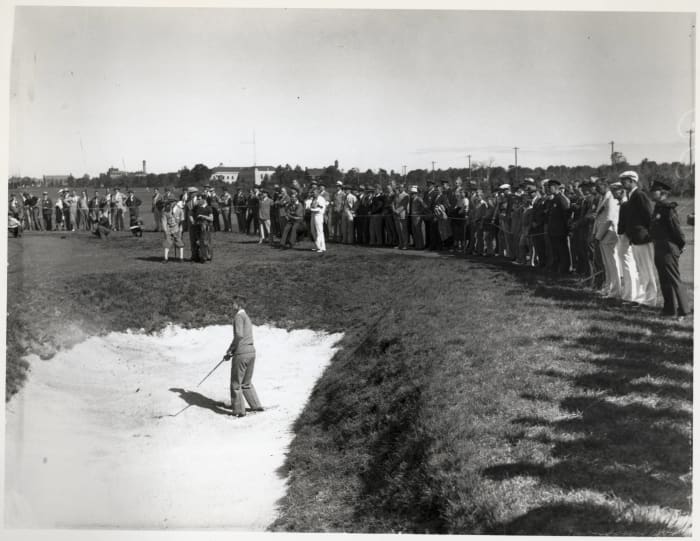No state has hosted the Men's U.S. Open more than New York, with this year's stop at famed Shinnecock Hills on Long Island marking No. 19 for N.Y. There have been plenty of memorable moments featuring legends like Bobby Jones, Billy Casper, Tiger Woods and Lee Trevino.
From Buffalo to Queens, New York has traditionally played a gracious host to this national championship and historically challenged golf's best to take their games to the next level, sometimes in excruciating fashion.
Here's our top 20 moments in New York's rich U.S. Open history.
20. Auchterlonie's garden stroll (1902)
Bettmann/Getty Images
Scotsman Laurie Auchterlonie became the first golfer in U.S. Open history to shoot below 80 for all four rounds and finished six strokes better than Stewart Gardner and amateur Walter Travis. Auchterlonie accomplished that feat at the Garden City Golf Club on Long Island in the second U.S. Open held in New York. From 1901-05, Auchterlonie was the only golfer other than Willie Anderson to win the event.
19. McDermott defends title in Buffalo (1912)
Tom Szczerbowski/Getty Images
A year after becoming the youngest golfer to win the U.S. Open at age 19, American John McDermott defended his title at the Country Club of Buffalo. McDermott was the first repeat champion since Willie Anderson's trifecta from 1903-05, but his career was essentially over at 23 while suffering from mental illness.
18. Local knowledge guides Sarazen (1932)
Bettmann/Getty images
It should not have been a surprise that Gene Sarazen won his second U.S. Open — 10 years after his first — on his former home course of Fresh Meadow Country Club. Sarazen was the club pro at the Queens course in the mid- to late 1920s. His final-round 66 was a record at the time.
17. Casper wins as Hogan fades (1959)
Augusta National/Getty Images
With Winged Foot playing host to the U.S. Open for the second time, Billy Casper claimed the first of his two titles. Casper led 46-year-old Ben Hogan by three strokes after three rounds. Though a potential final-round dual was there for the making, Hogan faded with a 76, and Casper, shooting 74, held off Bob Rosburg by a stroke.
16. Goosen edges Lefty for second championship (2004)
A. Messerschmidt/Getty Images
In the event's most recent trip to Shinnecock, Retief Goosen won his second U.S. Open by outlasting defending champion Phil Mickelson, the obvious crowd favorite. Mickelson was tied with Goosen after he birdied 15 and 16, but Lefty's double-bogey on the par-3 17th enabled the South African to win by two strokes.
15. Jones goes extra for third title (1929)
Augusta National/Getty Images
Winged Foot's U.S. Open debut provided the setting for Bobby Jones' third of four titles over an eight-year stretch. Despite a final-round 79, Jones went on to beat Al Espinosa in a 36-hole playoff by a resounding 23 strokes.
14. Future legends shine at Oak Hill (1956)
Bettmann/Getty Images
Though Cary Middlecoff topped Julius Boros and Ben Hogan for his second U.S. Open, this installment at Oak Hill Country Club was perhaps more memorable for the play of some of the game's up-and-coming stars. Ken Venturi was the low amateur with an eighth-place finish, a 24-year-old Billy Casper placed 14th in his first major and Arnold Palmer, 26, recorded his first of 13 top 10 U.S. Open finishes.
13. Arnie's U.S. Open streak ends (1984)
Mark Hoffman/Milwaukee Journal Sentinel via USA TODAY Network
Fuzzy Zoeller outlasted Greg Norman in an 18-hole playoff for another classic at Winged Foot, but the '84 event might be most remembered for who was not there. Specifically, Arnold Palmer, whose streak of 31 consecutive U.S. Open appearances dating to 1953, ended when the 1960 champion failed to make it out of a 36-hole qualifier.
12. Weather wins at Bethpage (2009)
Timothy A. Clary/AFP/Getty Images
The 2009 U.S. Open needed five days to complete thanks to consistent rain that resulted in some overly saturated course conditions at Bethpage Black. First-round play was suspended Thursday morning, and more rain forced the third round to resume Sunday afternoon. The final round started that evening and concluded Monday with surprise winner Lucas Glover taking advantage of late final-round struggles by an emotional Phil Mickelson, Ricky Barnes and David Duval.
11. Tiger tames Mickelson, Bethpage (2002)
Joe Maiorana/USA TODAY Sports
Seven years earlier, the weather at Bethpage was much better, but again, Phil Mickelson played the role of runner-up — the second of his record six times. Though Lefty shot a final-round 70, he still finished three shots back of wire-to-wire leader Tiger Woods, who claimed his second U.S. Open title in three years.
10. Floyd defies age (1986)
Thomas J. Russo/USA TODAY Sports
At 43 years and 284 days, Raymond Floyd became the oldest golfer to win a U.S. Open until 45-year-old Hale Irwin did it four years later. Floyd was part of a group three shots back of third-round leader Greg Norman, but he carded an impressive 66 for the final 18 while Norman posted a 75 at Shinnecock.
9. Trevino goes low to tie mark (1968)
Bettmann/Getty Images
The first of Lee Trevino's six major victories might have been the most impressive. The 28-year-old Trevino, en route to also winning his first PGA Tour event, matched a U.S. Open record with his four-round score of 275 at Oak Hill. His 5-under-par effort was four strokes better than defending champion Jack Nicklaus.
8. Racism rears its ugly head (1896)
Bettmann/Getty Images
The second U.S. Open and first to be held in New York — at Shinnecock Hills — featured perhaps the worst attempt of racial injustice in the tournament's history. Prior to the start of play, a petition was signed by several Scottish and English golfers intending to withdraw if 17-year-old African-American John Shippen and Native American Oscar Bunn remained in the field. The USGA, however, did not honor the petition, and both golfers played as scheduled.
7. Norman, New York don't mix (1984, '86, '95)
Luke Franke/Naples Daily News via USA TODAY Network
New York and the U.S. Open didn't go well together for Greg Norman. In 1984 at Winged Foot, the Shark lost in an 18-hole playoff to Fuzzy Zoeller. Two years later at Shinnecock, Norman led after the second and third rounds only to fall out of contention with a Sunday 75. Then in 1995, again at Shinnecock, Norman held a two-stroke lead after 36 holes, was tied for the lead after three rounds but finished second following a 73 on the final 18.
6. No Strange circumstance (1989)
Jason Getz/USA TODAY Sports
With Oak Hill as the backdrop, Curtis Strange became the last golfer to win back-to-back U.S. Opens and first since Ben Hogan in 1950-51. After a first-round 71, Strange carded a 64 to take the 36-hole lead but dropped three back after a 73 in the third. As leader Tom Kite faded, Strange regrouped with a 70 to earn his final PGA Tour victory.
5. Aces high (1989)
Stuart Franklin/Getty Images
Curtis Strange's defense of his U.S. Open title was impressive but perhaps not as much as the four holes-in-one on the same hole on the same day that were recorded during the '89 tournament at Oak Hill. On Friday, June 16, Doug Weaver, Mark Wiebe, Jerry Pate and Nick Price each used a 7-iron to remarkably ace the 167-yard sixth hole.
4. A star is born (1923)
Bettmann/Getty Images
A talented 21-year-old named Bobby Jones began his historical run at the U.S. Open — as an amateur — at Inwood Country Club in Long Island. Jones topped Bobby Cruickshank by two strokes in an 18-hole playoff to win the first of his four U.S. Open titles over an eight-year period. His four titles are tied with Willie Anderson, Ben Hogan and Jack Nicklaus for the most victories in U.S. Open history.
3. Phil's final-hole fold (2006)
John David Mercer/USA TODAY Sports
Seeking a third consecutive major victory and first at the U.S. Open, Phil Mickelson was tied for the lead after 54 holes at Winged Foot. However, during a wildly memorable final round, Lefty had a chance to win the tournament on the final hole, but his tee shot on 18 landed near a hospitality tent, his second hit a tree, third found a bunker, and fourth rolled off the green and into the rough. He missed the chip for bogey and a tie, thus making double-bogey for the fourth of those six runner-up finishes.
2. Pavin's 4-wood for the ages (1995)
J.D. Cuban/ALLSPORT via Getty Images
Corey Pavin was a solid PGA Tour player but hardly a favorite heading into Shinnecock in 1995, and he wasn't a serious contender during the first three rounds. But Pavin's 68 on Sunday — plus poor performances from Tom Lehman and Greg Norman — was highlighted by his second shot on the 18th: a 4-wood from roughly 228 yards out that landed five feet from the pin. He missed the birdie putt but made par to hold on for his only major win.
1. "The Massacre at Winged Foot" (1974)
Bettmann/Getty Images
Not a single golfer broke par during the first round in suburban New York City, and Hale Irwin's winning score of seven-over remains one of the highest since World War II. Known for its severely sloping greens, deep bunkers and tight, winding fairways, the course played tougher than expected and received so many complaints by the field that veteran sports writer Dick Schaap dubbed it "The Massacre at Winged Foot."

 +
+





















